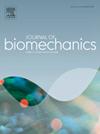步态过程中受力板漂移误差对预测关节动力学的临床研究。
IF 2.4
3区 医学
Q3 BIOPHYSICS
引用次数: 0
摘要
反动态分析是步态分析中用于估算节间力和净关节力矩的一种技术。逆动态计算容易出现各种形式的误差。其中一种误差是力板漂移,通常是由于输入连接器和电子元件内的湿气凝结造成的,从而导致输出随时间发生不希望的变化。对于在临床决策过程中需要考虑反向动力学的运动实验室来说,这一点尤为重要。制造商会提供漂移的容差水平。然而,临床上很少考虑可接受的漂移水平。因此,本研究旨在确定临床上可接受的力板漂移误差限值,该限值是通过将系统误差应用于力板通道,对步态过程中的下肢关节力矩进行预测而引起的。研究分析了 10 名发育典型儿童的步态数据,并在水平和垂直力通道上分别施加了 0.5 N、1 N、1.5 N、3 N、6 N 和 12 N 的诱导误差。对每个增量重新计算数据,并将平均曲线与无误差平均值(±1SD)带进行比较。当力矩超出平均值(±1SD)范围时,误差被认为具有临床意义。6 N 及以上的诱导误差足以导致临床显著变化。髋关节矢状面和冠状面力矩受影响最大,其次是膝关节,然后是踝关节。虽然制造商给出的可接受漂移值通常远低于 6 N,但在数分钟或更长时间内使用测力板时仍需谨慎,因为漂移值最终可能会超过临床可接受的范围。本文章由计算机程序翻译,如有差异,请以英文原文为准。
A clinical investigation of force plate drift error on predicted joint kinetics during gait
Inverse dynamic analysis is a technique used during gait analysis to estimate intersegmental forces and net joint moments. Inverse dynamic calculations are susceptible to various forms of error. One such error is force plate drift, often produced by humidity condensing within the input connectors and electronics, causing an undesired change in output over time. This can be particularly concerning for movement laboratories where inverse dynamics are considered in clinical decision-making processes. Manufacturers will provide tolerance levels for drift. However, levels of acceptable drift are rarely considered from a clinical perspective. Therefore, this study aims to establish clinically acceptable limits of force plate drift error, induced by applying systematic errors to force plate channels, on predicted lower limb joint moments during gait. Gait data of 10 children with typical development were analysed and induced errors of 0.5 N, 1 N, 1.5 N, 3 N, 6 N and 12 N were incrementally applied to the horizontal and vertical force channels. Data were recalculated for each increment and mean profiles compared to an error free mean (±1SD) band. Error was deemed clinically significant when moments fell outside the mean (±1SD) band. Induced error at 6 N and above was sufficient to cause a clinically significant change. Sagittal and coronal plane moments at the hip were most affected, followed by the knee and then the ankle. While manufacturer guidelines for acceptable drift are usually well below 6 N, care is needed when using force plates over several minutes or more as drift may eventually exceed clinically acceptable limits.
求助全文
通过发布文献求助,成功后即可免费获取论文全文。
去求助
来源期刊

Journal of biomechanics
生物-工程:生物医学
CiteScore
5.10
自引率
4.20%
发文量
345
审稿时长
1 months
期刊介绍:
The Journal of Biomechanics publishes reports of original and substantial findings using the principles of mechanics to explore biological problems. Analytical, as well as experimental papers may be submitted, and the journal accepts original articles, surveys and perspective articles (usually by Editorial invitation only), book reviews and letters to the Editor. The criteria for acceptance of manuscripts include excellence, novelty, significance, clarity, conciseness and interest to the readership.
Papers published in the journal may cover a wide range of topics in biomechanics, including, but not limited to:
-Fundamental Topics - Biomechanics of the musculoskeletal, cardiovascular, and respiratory systems, mechanics of hard and soft tissues, biofluid mechanics, mechanics of prostheses and implant-tissue interfaces, mechanics of cells.
-Cardiovascular and Respiratory Biomechanics - Mechanics of blood-flow, air-flow, mechanics of the soft tissues, flow-tissue or flow-prosthesis interactions.
-Cell Biomechanics - Biomechanic analyses of cells, membranes and sub-cellular structures; the relationship of the mechanical environment to cell and tissue response.
-Dental Biomechanics - Design and analysis of dental tissues and prostheses, mechanics of chewing.
-Functional Tissue Engineering - The role of biomechanical factors in engineered tissue replacements and regenerative medicine.
-Injury Biomechanics - Mechanics of impact and trauma, dynamics of man-machine interaction.
-Molecular Biomechanics - Mechanical analyses of biomolecules.
-Orthopedic Biomechanics - Mechanics of fracture and fracture fixation, mechanics of implants and implant fixation, mechanics of bones and joints, wear of natural and artificial joints.
-Rehabilitation Biomechanics - Analyses of gait, mechanics of prosthetics and orthotics.
-Sports Biomechanics - Mechanical analyses of sports performance.
 求助内容:
求助内容: 应助结果提醒方式:
应助结果提醒方式:


